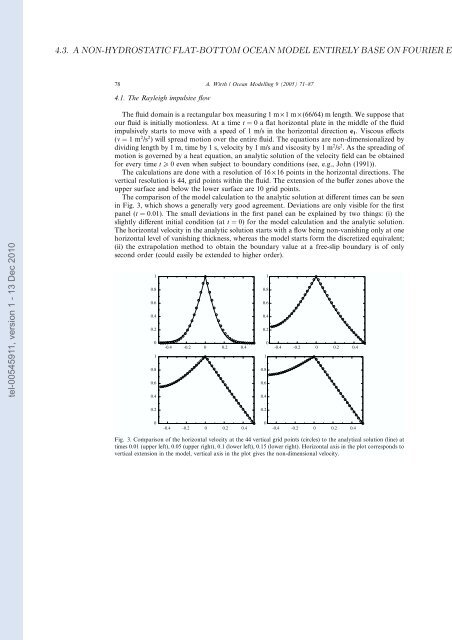Etudes et évaluation de processus océaniques par des hiérarchies ...
Etudes et évaluation de processus océaniques par des hiérarchies ...
Etudes et évaluation de processus océaniques par des hiérarchies ...
You also want an ePaper? Increase the reach of your titles
YUMPU automatically turns print PDFs into web optimized ePapers that Google loves.
4.3. A NON-HYDROSTATIC FLAT-BOTTOM OCEAN MODEL ENTIRELY BASE ON FOURIER EX<br />
78 A. Wirth / Ocean Mo<strong>de</strong>lling 9 (2005) 71–87<br />
4.1. The Rayleigh impulsive flow<br />
tel-00545911, version 1 - 13 Dec 2010<br />
The fluid domain is a rectangular box measuring 1 m·1 m·(66/64) m length. We suppose that<br />
our fluid is initially motionless. At a time t ¼ 0 a flat horizontal plate in the middle of the fluid<br />
impulsively starts to move with a speed of 1 m/s in the horizontal direction e 1 . Viscous effects<br />
(m ¼ 1 m 2 /s 2 ) will spread motion over the entire fluid. The equations are non-dimensionalized by<br />
dividing length by 1 m, time by 1 s, velocity by 1 m/s and viscosity by 1 m 2 /s 2 . As the spreading of<br />
motion is governed by a heat equation, an analytic solution of the velocity field can be obtained<br />
for every time tP 0 even when subject to boundary conditions (see, e.g., John (1991)).<br />
The calculations are done with a resolution of 16·16 points in the horizontal directions. The<br />
vertical resolution is 44, grid points within the fluid. The extension of the buffer zones above the<br />
upper surface and below the lower surface are 10 grid points.<br />
The com<strong>par</strong>ison of the mo<strong>de</strong>l calculation to the analytic solution at different times can be seen<br />
in Fig. 3, which shows a generally very good agreement. Deviations are only visible for the first<br />
panel (t ¼ 0:01). The small <strong>de</strong>viations in the first panel can be explained by two things: (i) the<br />
slightly different initial condition (at t ¼ 0) for the mo<strong>de</strong>l calculation and the analytic solution.<br />
The horizontal velocity in the analytic solution starts with a flow being non-vanishing only at one<br />
horizontal level of vanishing thickness, whereas the mo<strong>de</strong>l starts form the discr<strong>et</strong>ized equivalent;<br />
(ii) the extrapolation m<strong>et</strong>hod to obtain the boundary value at a free-slip boundary is of only<br />
second or<strong>de</strong>r (could easily be exten<strong>de</strong>d to higher or<strong>de</strong>r).<br />
1<br />
0.8<br />
0.6<br />
0.4<br />
0.2<br />
0<br />
1<br />
0.8<br />
0.6<br />
0.4<br />
-0.4 -0.2 0 0.2 0.4<br />
1<br />
0.8<br />
0.6<br />
0.4<br />
0.2<br />
1<br />
0.8<br />
0.6<br />
0.4<br />
0<br />
-0.4 -0.2 0 0.2 0.4<br />
0.2<br />
0.2<br />
0<br />
-0.4 -0.2 0 0.2 0.4<br />
0<br />
-0.4 -0.2 0 0.2 0.4<br />
Fig. 3. Com<strong>par</strong>ison of the horizontal velocity at the 44 vertical grid points (circles) to the analytical solution (line) at<br />
times 0.01 (upper left), 0.05 (upper right), 0.1 (lower left), 0.15 (lower right). Horizontal axis in the plot corresponds to<br />
vertical extension in the mo<strong>de</strong>l, vertical axis in the plot gives the non-dimensional velocity.
















